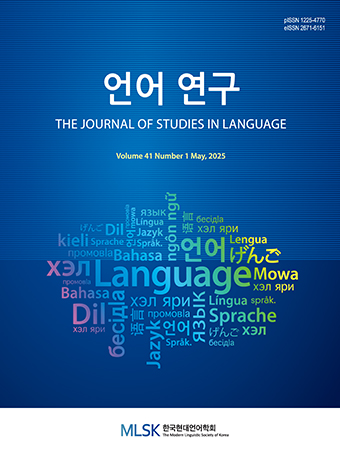Research Article
Abstract
References
Information
By utilizing COCA (Corpus of Contemporary American English) and concordancer software, practical and authentic collocation materials can be designed to study the collocation and usage of “noun+wine, noun+beer, noun+coffee, noun+juice, noun+sandwich”. The retrieved collocation material is analyzed and processed as meaningful learning data in classrooms and actual situations. This article describes the present collocation-related teaching materials, especially collocation materials of “wine, beer, coffee, juice, sandwich”. This study will bring practical benefits to teaching English as a foreign language in general and improving students’ knowledge of actual English vocabulary for specific purposes in particular. The collocation materials produced by this study will also make a general contribution to teaching English for wider areas and especially for academic purposes.
- 김미영. 2013. 연어를 활용한 어휘 교육 방법 연구. 『새한영어영문학』 55.1, 215-232. 10.25151/nkje.2013.55.1.010
- 신길호. 2013. 대학생의 영어 연어 사용 능력에 관한 연구. 『영어영문학연구』 55.1, 239-268. 10.18853/jjell.2013.55.1.011
- 정연찬, 염지민, 장세은. 2006. 코퍼스에 기반한 한국 중학생의 영어 유의어 연어능력에 관한 연구. 『새한영어영문학』 48.4, 247-272.
- 현태덕, 신재숙. 2005. 단어 완성하기 활동을 통한 어휘지도. Studies in English Education 10.1, 25-44.
- Bahns, J. and M. Eldaw. 1993. Should We Teach EFL Students Collocations? System 21.1, 101-114. 10.1016/0346-251X(93)90010-E
- Butler, J. 1991. Cloze Procedures and Concordances: The Advantages of Discourse Level Authenticity in Testing Expectancy Grammar. System 19.1-2, 29-38. 10.1016/0346-251X(91)90005-A
- Carter, R. 1998. Vocabulary: Applied Linguistic Perspectives. London: Routledge. 10.4324/9780203270110
- Channell, J. 1981. Applying Semantic Theory to Vocabulary Teaching. ELT Journal 35, 112-115. 10.1093/elt/XXXV.2.115
- Ellis, N. C. 1997. Vocabulary Acquisition: Word Structures, Collocation, Word-class, and Meaning. In N. Schmitt and M. McCarthy (Eds.), Vocabulary: Description, Acquisition and Pedagogy. Cambridge: Cambridge University Press, 122-139.
- Ellis, N. C. 2003. Constructions, Chunking, and Connectionism: The Emergence of Second Language Structure. In C. J. Doughty and M. H. Hong (Eds.), The Handbook of Second Language Acquisition. Oxford: Blackwell, 63-103. 10.1002/9780470756492.ch4
- Firth, J. 1957. A Synopsis of Linguistic Theory. In J.R. Firth (Ed.), Studies in Linguistic Analysis, Special Volume. Oxford: Blackwell, 1-32.
- Gabrys-Biskup, D. 1992. L1 Influence on Learners’ Renderings of English Collocations: A Polish/German Empirical Study. In Arnaud, P. and H. Bejoint (Eds.), Vocabulary and Applied Linguistics. London: Macmillan, 85-93. 10.1007/978-1-349-12396-4_8
- Hill, J. 2000. Revising Priorities: From Grammatical Failure to Collocational Success. In M. Lewis (Ed.), Teaching Collocation: Further Developments in Lexical Approach. London: Language Teaching Publications, 47-69.
- Johns, T. 1991. Should You Be Persuaded: Two Samples of Data-driven Learning Materials. ELR Journal 4.1, 1-16.
- Keshavarz, H. and H. Salimi. 2007. Collocational Competence and Cloze Test Performance: A Study of Iranian EFL Learners. International Journal of Applied Linguistics 17.1, 81-92. 10.1111/j.1473-4192.2007.00134.x
- Leech, G. 2000. Grammars of Spoken English: New Implications of Corpus-oriented Research. Language Learning 50.3, 675-724. 10.1111/0023-8333.00143
- Lewis, M. 1993. The Lexical Approach: The State of ELT and a Way Forward. London: Language Teaching Publications.
- Lewis, M. 1997. Implementing the Lexical Approach: Putting Theory into Practice. London: Language Teaching Publications.
- Lewis, M. 2000. Language in the Lexical Approach. In M. Lewis (Ed.), Teaching Collocation: Further Developments in Lexical Approach. London: Language Teaching Publications, 126-185.
- Lin, M. 2016. Effects of Corpus-Aided Language Learning in the EFL Grammar Classroom: A Case Study of Students’ Learning Attitudes and Teachers’ Perceptions in Taiwan. TESOL Quarterly 50.4, 871-893. 10.1002/tesq.250
- Lan, G., K. Lucas, and Y. Sun. 2019. Does L2 Writing Proficiency Influence Noun Phrase Complexity? System 85, 102-116. 10.1016/j.system.2019.102116
- Lu, X. 2011. A Corpus‐Based Evaluation of Syntactic Complexity Measures as Indices of College‐Level ESL Writers’ Language Development. TESOL Quarterly 45.1, 36-62. 10.5054/tq.2011.240859
- Nation, I. 2001. Learning Vocabulary in Another Language. Cambridge: Cambridge University Press. 10.1017/CBO9781139524759 PMC90373
- Park, S. 2012. A Corpus-based Study of Syntactic Complexity Measures as Developmental Iindices of College-level l2 Learners’ Proficiency in Writing. Applied Linguistics 28.3, 139-160. 10.17154/kjal.2012.09.28.3.139
- Poole, R. 2016. A Corpus-aided Approach for the Teaching and Learning of Rhetoric in an Undergraduate Composition Course for L2 Writers. Journal of English for Academic Purpose 21, 99-109. 10.1016/j.jeap.2015.12.003
- Satake, Y. 2020. How Error Types Affect the Accuracy of L2 Error Correction with Corpus Use. Journal of Second Language Writing 50, 107-57. 10.1016/j.jslw.2020.100757
- Schmitt, N. 2010. Vocabulary in Language Teaching. Cambridge and New York: Cambridge University Press.
- Sinclair, J. 1991. Corpus, Concordance, Collocation. Oxford: Oxford University. Press.
- Struc, N. and N. Wood. 2010. A Corpus-based Analysis of Japanese University-level Learners' L2 Writing Development over a One-year Period. Reitaku University Journal 75-90.
- Publisher :The Modern Linguistic Society of Korea
- Publisher(Ko) :한국현대언어학회
- Journal Title :The Journal of Studies in Language
- Journal Title(Ko) :언어연구
- Volume : 37
- No :3
- Pages :359-376
- DOI :https://doi.org/10.18627/jslg.37.3.202111.359




 The Journal of Studies in Language
The Journal of Studies in Language






